To prevent rust in lye-safe mixing equipment, use 304 or 316 stainless steel tools and rinse them immediately after use with cold water. Dry equipment thoroughly before storage and keep in well-ventilated areas away from humidity. Apply protective coatings to metal components when appropriate, and inspect regularly for early signs of corrosion like discoloration or pitting. Investing in quality equipment ultimately saves money and guarantees better soap quality. The following tips will transform your equipment maintenance routine.
NUMERIC LIST OF 13 SECOND-LEVEL HEADING(S)
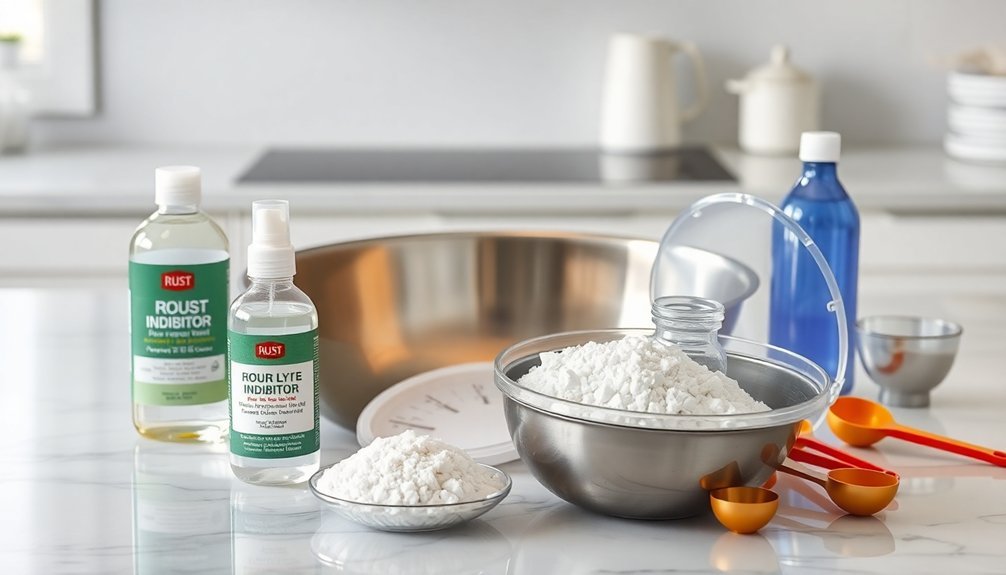
While preventing rust in mixing equipment requires a thorough approach, understanding the key areas to focus on is essential.
Your effective rust prevention strategy should address these critical components:
Protect your investment by implementing a comprehensive rust prevention strategy focused on these essential components.
- Selecting Lye-Compatible Materials
- Proper Equipment Cleaning Techniques
- Ideal Storage Solutions
- Rust-Resistant Coatings and Treatments
- Workspace Ventilation Requirements
- Protective Gear Essentials
- Safe Lye Handling Procedures
- Spill Management Protocols
- Routine Maintenance Schedules
- Environmental Control Measures
- Emergency Response Preparation
- Equipment Inspection Guidelines
- Chemical Segregation Practices
When selecting containers, always prioritize vessels made of high density polyethylene or polypropylene to prevent dangerous chemical reactions with lye.
Understanding Lye Corrosion in Soap Making Equipment
Lye's highly alkaline nature triggers aggressive chemical reactions with metals like aluminum, resulting in pitting, discoloration, and eventual structural failure of your soap making equipment.
You'll notice early warning signs of lye corrosion when your metal tools develop a dull appearance, rough texture, or visible etching on previously smooth surfaces.
When you spot these indicators, immediately replace affected equipment, as continued use risks contaminating your soap batches and potentially causing equipment failure during production. To avoid these issues, always use stainless steel bowls or glass containers when working with lye solutions during the soap making process.
Chemical Reactions Explained
When sodium hydroxide (lye) meets your mixing equipment, a complex chemical reaction begins that can threaten the integrity of your tools. Lye is highly alkaline (pH 13-14) and readily reacts with metals through an oxidation process. This reaction accelerates when heat is generated during saponification, intensifying lye's corrosive properties. The saponification value of your selected fats determines exactly how much sodium hydroxide will be active in your mixture, directly influencing the corrosion potential.
The chemistry is straightforward: sodium hydroxide breaks down the protective oxide layer on metals, exposing fresh material to continuous attack. For aluminum and other reactive metals, this creates aluminum hydroxide and hydrogen gas—a dangerous combination that weakens your equipment over time.
Even stainless steel isn't completely immune, as lye can attack chromium oxide layers that provide corrosion resistance, especially at high concentrations or temperatures. That's why choosing HDPE, polypropylene, or high-grade stainless steel is essential for long-term equipment performance.
Corrosion Warning Signs
Recognizing corrosion warning signs early can save you significant time and money when working with lye in soap making.
Watch for discoloration or fading on your equipment surfaces—this often indicates chemical attack has begun. If you notice cracks, pits, or irregular textures developing on your mixing bowls or utensils, replace them immediately.
When using plastic containers, be alert for any warping, softening, or melting, which means the material isn't lye-resistant. Never use aluminum containers as lye can react with them to produce flammable hydrogen gas.
Small bubbles forming when lye touches metal surfaces indicate a dangerous hydrogen gas release. This reaction isn't just damaging your equipment—it's creating a fire hazard.
Pay attention to unexpected odors or color changes in your lye solution, as these signal unwanted chemical reactions with your equipment that could compromise your soap quality.
Essential Materials for Rust-Resistant Soap Vessels
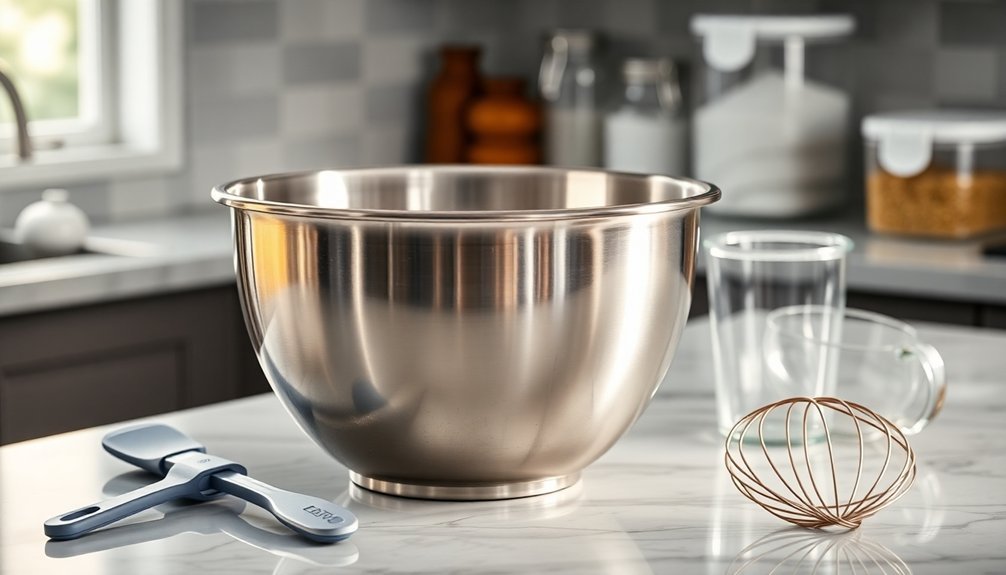
Selecting the right materials for soap making equipment proves critical in preventing rust formation and guaranteeing longevity.
Stainless steel (304) stands out as your premier option, offering exceptional corrosion resistance and durability in humid conditions.
Stainless steel 304 reigns supreme for soap making, withstanding corrosion while maintaining integrity through countless production cycles.
Polypropylene (PP#5) provides a cost-effective alternative that's both chemically resistant and microwave-safe.
For premium durability, consider titanium-coated vessels, which offer superior protection against caustic substances.
HDPE#2 works well for storing cooled lye solutions but isn't suitable for hot processes.
Ceramic oxide, commonly found in crockpots, delivers excellent temperature tolerance and chemical resistance.
When choosing your equipment, prioritize materials with high melting points and review Chemical Resistance Data to guarantee safety.
Avoid reactive metals like aluminum and copper which can cause dangerous chemical reactions with soap ingredients.
Always work with materials rated A for lye, as these will resist chemical deterioration and maintain their integrity throughout the soap-making process.
The Chemistry Behind Lye and Metal Interactions
Understanding the chemistry behind lye and metal interactions is essential for soap makers who want to prevent equipment deterioration.
Sodium hydroxide (lye) is highly corrosive and reacts differently with various metals in your equipment. When lye contacts aluminum, it creates a vigorous reaction that produces sodium aluminate and flammable hydrogen gas.
Similarly, it dissolves zinc and lead in concentrated solutions. This reactivity makes these metals unsuitable for soap making equipment.
However, stainless steel remains your best option because lye doesn't react with iron at room temperature. Glass containers can work but may slowly degrade with prolonged exposure, especially at higher temperatures.
Always wear protective gear when handling lye, as it causes severe chemical burns and creates harmful environmental impacts if improperly disposed of.
Selecting Stainless Steel Grades for Long-Term Use
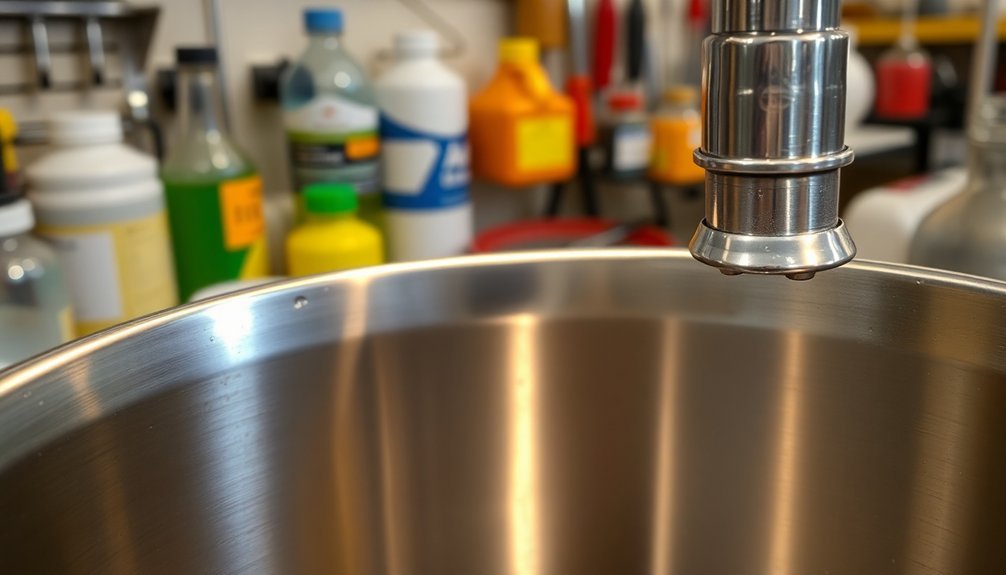
When selecting stainless steel for your mixing equipment, you'll need to understand the vital differences between 304 and 316 grades, with 316 offering superior corrosion resistance against chemicals like lye.
The quality of the alloy directly impacts your equipment's longevity, as higher-grade materials withstand harsh processing conditions far better than budget alternatives. Similar to how model evaluation results help assess performance in AI systems, proper material testing ensures optimal equipment functionality.
You can quickly verify your stainless steel's grade using a simple magnetic testing method, as true austenitic stainless steel exhibits minimal magnetic properties compared to lower-quality substitutes.
304 Vs 316 Grades
The three primary factors that differentiate 316 stainless steel from other grades make it an ideal choice for mixing equipment exposed to corrosive environments. Most importantly, 316 contains molybdenum, which greatly enhances its resistance to pitting and crevice corrosion compared to 304 grades.
When you're working with lye or other caustic chemicals, 316's superior chloride resistance becomes invaluable. While you'll pay more upfront compared to 304 stainless steel, you'll benefit from longer equipment life and reduced maintenance costs.
The grade maintains its structural integrity at temperatures up to 870°C continuously, making it suitable for high-temperature mixing processes.
If your equipment will be exposed to harsh chemicals, marine environments, or frequent cleaning cycles, investing in 316 stainless steel is worth the additional cost for its enhanced durability and corrosion resistance.
Alloy Quality Matters
Quality differences within stainless steel alloys considerably impact your equipment's longevity when exposed to caustic substances like lye. Not all stainless steel is created equal—higher grades like 304 offer superior corrosion resistance essential for soap making equipment.
When selecting mixing tools, prioritize alloys with high chromium and nickel content. These elements enhance resistance to the highly alkaline nature of lye solutions. Avoid lower-grade options that might contain aluminum, which reacts with lye and can release dangerous hydrogen gas. Ensure you're using pure stainless steel pots without aluminum components to prevent dangerous chemical reactions during soap making.
Remember that proper finish quality also matters. A #4 finish provides better protection against chemical exposure.
Don't compromise on quality—investing in pure, high-grade stainless steel (US 304) prevents premature deterioration, guarantees safer soap production, and saves you from frequent replacements due to rust or corrosion.
Magnetic Testing Method
Identifying authentic stainless steel can be challenging when sourcing mixing equipment for your soap making operation. A simple magnetic test can help you verify if you're getting the right grade for your caustic environment.
When testing your equipment, remember:
- Non-magnetic response indicates austenitic grades (304, 316) – ideal for lye resistance
- Strong magnetic attraction suggests ferritic or martensitic grades – potentially less corrosion-resistant
- Test multiple areas as work hardening can create localized magnetic spots
- Clean the surface thoroughly before testing to prevent false readings from contamination
While magnetic testing isn't definitive alone, it's a quick, non-destructive screening method that can save you from costly mistakes.
For critical equipment, combine this test with documentation verification or professional analysis to guarantee you're investing in truly lye-resistant materials.
HDPE and PP Containers: The Plastic Advantage

When selecting containers for your soap-making materials, high-density polyethylene (HDPE) and polypropylene (PP) stand out as superior alternatives to metals that might rust.
These plastics offer excellent chemical resistance to lye, ensuring safe handling of both NaOH and KOH.
You'll recognize HDPE containers by their #2 recycling code, commonly found in detergent bottles. They're cost-effective and perfect for storing cooled lye solutions at temperatures up to 190°F.
PP containers, marked with #5, provide enhanced heat resistance—they won't soften even with boiling water, making them ideal for mixing hot lye.
For best results, use PP containers when mixing lye solutions and HDPE for long-term storage.
Never repurpose these containers for food after using them with lye. Always look for thick-walled containers that can withstand the heavier weight of lye solutions without breaking or deforming.
Proper Cleaning Techniques to Prevent Oxidation
You'll need to rinse your mixing equipment immediately after use with cold water to prevent lye residue from setting.
Follow up with pH-neutral cleaning solutions that won't react with any remaining alkaline substances or damage the equipment's surface.
Once cleaned, dry your tools completely using absorbent cloths or warm air to eliminate any moisture that could trigger oxidation or rust formation.
Immediate Post-Use Rinse
The immediate post-use rinse represents the first critical defense against rust formation in mixing equipment. After working with lye, rinse your equipment thoroughly with plain, cold water right away to remove any residual caustic material that could damage surfaces over time.
- Always wear protective gear including gloves and goggles during the rinse process.
- Use only heat-resistant containers made of stainless steel or appropriate plastics when handling lye.
- Rinse hard-to-reach areas carefully, as hidden lye residue can cause long-term damage.
- Dry equipment completely after rinsing to eliminate moisture that contributes to oxidation.
Avoid using containers made of tin or aluminum as the highly caustic lye will react with these metals and potentially contaminate your soap mixture.
Remember not to use vinegar directly on equipment that hasn't been thoroughly rinsed first, as it can react with lye.
Immediate cleaning prevents both safety hazards and extends the lifespan of your valuable mixing tools.
Ph-Neutral Cleaning Solutions
After thoroughly rinsing equipment to remove lye residue, choosing pH-neutral cleaning solutions becomes your next critical defense against rust and oxidation.
Products like Rust Away, Evapo-Rust, and Neutral RR effectively break down iron oxide bonds without damaging your valuable equipment.
These cleaners work through selective chelation, removing rust while protecting materials including rubber, plastic, and most metals.
You'll appreciate their non-toxic, biodegradable formulas that produce no harsh fumes or odors during use.
For stubborn rust, try soaking methods enhanced with mild heat or ultrasonics to improve efficiency.
The best part? Many of these solutions are reusable, reducing chemical waste.
They'll even inhibit flash rusting for weeks after application, giving your equipment longer-lasting protection without the need for harsh chemicals.
Thorough Drying Methods
Thoroughly drying your mixing equipment stands as the single most critical step in preventing rust formation, since even trace amounts of moisture can trigger oxidation within hours.
After cleaning your lye-safe mixing tools, implement a thorough drying protocol that eliminates all moisture from metal surfaces.
- Use controlled heat sources like hair dryers or heat guns to quickly evaporate water, especially from crevices and joints.
- Place desiccants near your stored equipment to absorb any residual moisture that might accumulate.
- Guarantee proper air circulation around drying equipment by spacing items and using fans when necessary.
- Inspect your equipment before storage, looking for water droplets in threaded areas or hard-to-reach spots.
Never store equipment that shows any signs of dampness, even if it appears mostly dry.
Storage Solutions for Extended Equipment Life
Implementing proper storage solutions greatly extends the life of your mixing equipment while preventing costly rust damage.
Store your equipment in dry, well-ventilated areas to minimize moisture exposure—the primary culprit behind rust formation.
Choose dedicated storage cabinets made from chemicals-resistant materials like HDPE or polypropylene.
Always guarantee your equipment is thoroughly cleaned and completely dry before storage.
Apply protective coatings to metal components that might come in contact with lye solutions.
Our high-quality lye tanks feature 304 stainless steel construction that naturally resists rust and corrosion even with repeated use.
Keep your lye containers in airtight, properly labeled vessels made of thick-walled HDPE with secure screw-on caps.
Store these separately from your equipment to prevent accidental contact.
Establish a regular inspection routine to catch early signs of wear or corrosion.
This proactive approach will considerably reduce replacement costs and guarantee your equipment remains safe to use.
Signs Your Soap Making Vessels Need Replacement
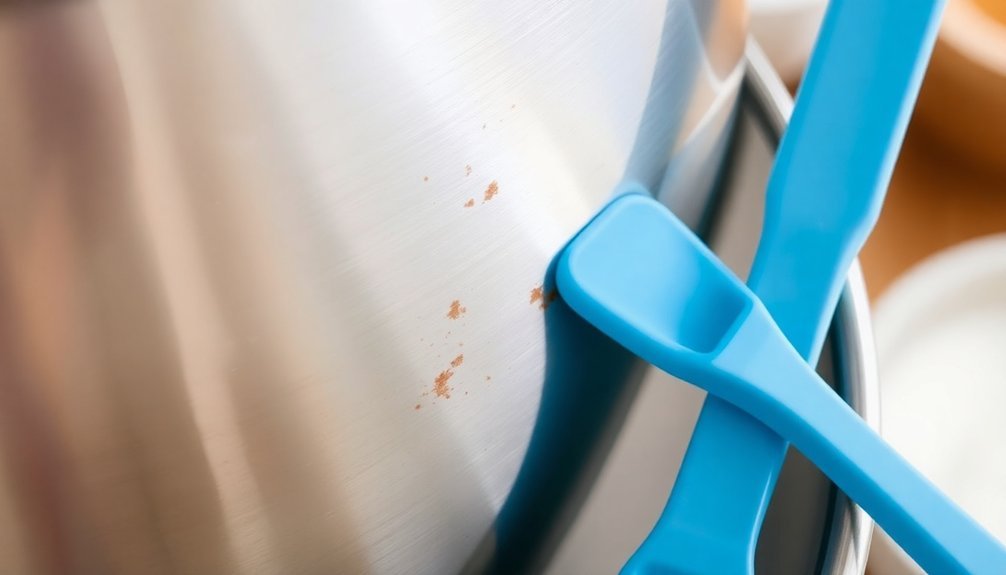
Identifying when your soap making equipment requires replacement is essential for maintaining product quality and safety.
Don't wait until your tools completely fail before replacing them—doing so risks contaminating your soap or causing accidents during production.
Watch for these telltale indicators that it's time to invest in new equipment:
- Rust spots, flaking, or pitting on metal surfaces, which can contaminate your soap batches and compromise quality
- Cracks, leaks, or warping in containers that once held their shape perfectly
- Decreased mixing performance or uneven heating patterns that affect your soap's consistency
- Discoloration or etching on non-metallic vessels, especially those that have contacted lye solutions
When selecting replacement equipment, prioritize stainless steel attachments rather than aluminum or painted options that can degrade when exposed to caustic solutions.
Remember that equipment made from aluminum or non-lye-safe plastics will deteriorate quickly and should be replaced with proper materials.
Treating Minor Rust Before It Spreads
Minor rust spots can quickly develop into considerable corrosion problems if left untreated, especially in soap making equipment where moisture and chemical exposure are constant factors.
Early detection gives you the best chance of successful removal.
For small rust spots, use a wire brush or sandpaper to gently scrub the affected area.
Once cleaned, apply a rust converter containing phosphoric acid to neutralize remaining rust.
Always wear protective gloves and goggles during this process.
After treatment, thoroughly rinse and dry the equipment, then apply a food-grade rust inhibitor to prevent future corrosion.
Consider using electrolysis for intricate parts where mechanical removal isn't practical.
Regular inspection and immediate treatment of rust spots will considerably extend your equipment's lifespan and maintain product quality.
Environmental Factors Affecting Equipment Longevity
The environment surrounding your mixing equipment plays a critical role in determining its operational lifespan, often more significant than the quality of the equipment itself. A controlled environment prevents premature deterioration while extending your investment's functional life.
Key environmental factors you'll need to manage include:
- Temperature fluctuations – Both extremes cause material stress, with high temperatures breaking down lubricants and low temperatures making components brittle.
- Humidity levels – Excess moisture accelerates corrosion and promotes bacterial growth.
- Vibration exposure – Constant vibration loosens fasteners and disrupts critical alignments.
- Power quality – Voltage inconsistencies damage precision components and controls.
The Cost-Benefit Analysis of Quality Soap Making Tools
While many new soap makers initially focus on minimizing startup costs, investing in quality equipment offers substantial long-term advantages that outweigh the initial expense. Quality tools typically range from $200-$1,000 initially but deliver significant returns through improved efficiency and reduced waste.
Investing in premium soap-making equipment upfront saves money long-term through enhanced efficiency and reduced material waste.
Higher-grade equipment requires less maintenance, lasts longer, and includes essential safety features that protect you during the soap-making process. Though you might spend more upfront, you'll save money through fewer replacements and repairs.
Quality tools also enable you to innovate and adapt recipes more effectively. Implementing inventory tracking software can help you manage your equipment and ingredient costs more efficiently. When calculating your investment, consider how improved equipment affects your cost per bar and production capacity.
Remember that efficient equipment can transform your $500-$2,000 startup into a streamlined operation with optimized batch sizes and higher profit margins.
Protective Coatings and Their Application Methods
Protective coatings serve as an essential defense mechanism for your soap-making equipment, particularly when exposed to caustic ingredients like lye.
Selecting the right coating depends on your specific equipment and working environment, with both oil-based and water-based options offering distinct advantages.
When applying protective coatings, consider these proven methods:
- Spray application works best for covering large surfaces evenly
- Dip application guarantees thorough protection for smaller components
- Brush or wipe techniques allow precision for detailed areas
- Layer application provides superior protection in harsh environments
Proper surface preparation is critical—clean thoroughly before coating to guarantee adhesion.
Always remember to use stainless steel pot for mixing ingredients with lye to help prevent rust and chemical reactions.
Allow sufficient drying time between applications, and always verify your coating's compatibility with lye to prevent unexpected chemical reactions during soap production.
Frequently Asked Questions
Can I Use Silicone Molds When Working With Lye Solutions?
Yes, you can safely use silicone molds with lye solutions. They're resistant to lye, don't leach chemicals, withstand heat generated during saponification, and make it easy to release your finished soap after hardening.
How Do Electromagnetic Fields Affect Lye-Metal Interactions?
Electromagnetic fields can alter electron behavior at metal surfaces, potentially affecting lye-metal reactions. They may accelerate or inhibit corrosion by changing electrochemical processes, especially when you're working with highly reactive metals.
Does Water Hardness Impact Rust Formation in Lye Equipment?
Yes, water hardness impacts rust formation in lye equipment. Hard water minerals can create deposits that form corrosion cells, while soft water lacks protective mineral coatings. You'll need proper water treatment to minimize these effects.
Can Anodized Aluminum Safely Handle Lye for Soap Making?
No, you shouldn't use anodized aluminum with lye for soap making. The anodization layer won't protect against lye, which can react with aluminum to produce dangerous hydrogen gas and potentially damage your equipment.
Will Temperature Fluctuations Accelerate Equipment Deterioration During Seasonal Storage?
Yes, temperature fluctuations will accelerate your equipment's deterioration during storage. They cause expansion and contraction of materials, leading to mechanical stress, brittleness in cold conditions, and can promote condensation that triggers rust formation.
In Summary
You've now got the knowledge to protect your soap making equipment from lye corrosion. By choosing the right materials, understanding the chemical processes, and implementing proper maintenance, you'll extend your tools' lifespan while saving money. Don't wait until rust appears—be proactive with protective coatings and regular checks. Your equipment deserves this care, and you'll enjoy smoother soap making for years to come.

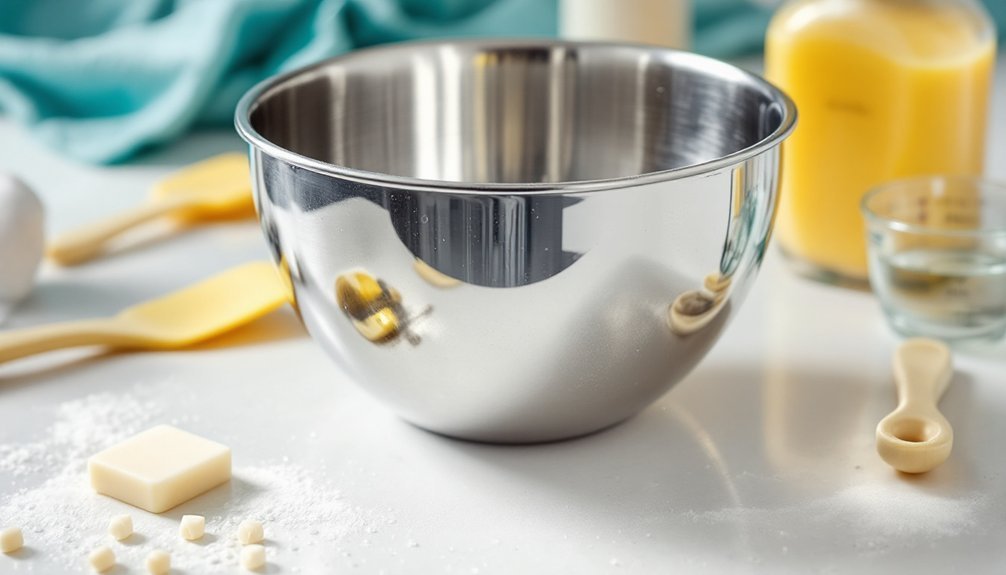



Leave a Reply